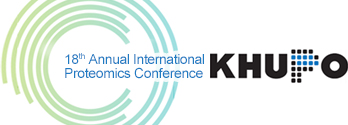Plenary Speakers
Home
> Program > Plenary Speakers

- Code / Date
- PL-1 / March 29 (Thu) 09:10-09:50
- Speaker
- Christopher M. Overall CV
- Affiliation
- University of British Columbia, Canada
- Title
- Target Identification by TAILS N-Terminal Positional Proteomics Leads to Development of a Pharmacological Molecular Corrector for Impaired NF-kB Activation
- Career
- Professor Overall started his UBC lab in 1993 after a MRC Centennial Fellowship with Dr. Michael Smith, Nobel Laureate (1989-), with subsequent pharmaceutical experience at British Biotech, Oxford (1997-1998) and Novartis, Basel (2004/2008). He is a Tier 1 Canada Research Chair in Protease Proteomics, Life Sciences Institute with cross-appointments/affiliations with the Center for Blood Research, Department Biochemistry/Molecular Biology, and is an Honorary Professor, Albert-Ludwigs Universität Freiburg.
As recognized by the 2017 HUPO Discovery Award in Proteomics Sciences, he is best known for two related but distinct scientific achievements. The first is development of new proteomic methods for discovery of protein substrates of proteolytic enzymes e.g., TAILS, PICS, ATOMS, which allow identification of protease cleavage sites and substrates in vivo for the first time. Thereby he established the field of degradomics. The second is levering these techniques to reveal new and often unexpected biological roles for proteases in vivo and their aberrations in disease. The significance of his research has been recognized by many Awards including: 2002 CIHR Researcher of the Year; Tony Pawson Award (2014); and the Proteomass Scientific Society Award (2017). He was elected to the HUPO Executive Council and to Co-Chair HUPO’s Chromosome-Centric Human Proteome Project.
With 258 refereed papers (h-index 85,~26,000 citations, 30 >200), including 27 Nature(1), Science(2), and daughter journal (24) papers, he has mentored 37 PDFs—4 of whom are Full Professors, 3 Associate Professors, and 8 are Assistant Professors. - Abstract
-

- Code / Date
- PL-2 / March 29 (Thu) 16:25-17:05
- Speaker
- Bernhard Küster CV
- Affiliation
- Technical University of Munich, Germany
- Title
- The target landscape of clinical kinase drugs
- Career
- Professor Kuster has been engaging researches in the field of chemical and functional proteomics. He firstly developed Kino-bead for kinome analysis and reported TPP (Thermal proteome profiling) for target identification of non-tagging small molecules. His group has uncovered how proteins interact with each other and with active pharmaceutical agents, and how these can be used for individual approaches to clinical treatment.
- Abstract
-

- Code / Date
- PL-3 / March 30 (Fri) 09:10-09:50
- Speaker
- David R. Goodlett CV
- Affiliation
- University of Maryland School of Pharmacy, USA
- Title
- From a Histroical Review of Developments leading to Shotgun Proteomics to Longitudinal Profiling
- Career
- Prof Goodlett has spent his career using mass spectrometry to solve biomedical problems via novel technology and software developments. He has been active in a variety of fields including medicine, oceanography, pharmacy, microbiology, proteomics (including clinical applications), lipidomics, and protein & glycolipid structure-function relationships publishing over 240 papers. He has been a Professor at the University of Maryland (2013-present) and the University of Washington (2004-2012) as well as first Director of Proteomics at the Institute for Systems Biology (2000-2003). From 2012-2016 he was a Finland Distinguished Professor; https://www.youtube.com/watch?v=jfOOMNJivvY. He is an Editor at Rapid Communications in Mass Spectrometry and a co-organizer of www.msbm.org. In 2018 he will join the International Centre for Cancer Vaccine Science (ICCVS) at the University of Gdansk as a Visiting Professor to set up proteomics within the centre.
- Abstract
-

- Code / Date
- PL-4 / March 30 (Fri) 16:05-16:45
- Speaker
- Young-Ki Paik CV
- Affiliation
- Yonsei University, Korea
- Title
- Quest for Dark Proteins in Biomedical Sciences
- Career
- After receiving his doctorate degree at the University of Missouri-Columbia, USA, in 1983, Prof. Paik took a postdoctoral position at the Gladstone Institute of Cardiovascular Diseases, UCSF until 1986 when he became a Staff Research Investigator. After leaving the Gladstone Institute in 1989, he returned to Seoul and had an associate professorship at the Department of Biochemistry, Hanyang University (1989-1993) and the Department of Biochemistry, Yonsei University (1993-95). In 1995, Paik became a full Professor, and in 2000 was appointed Director of the Yonsei Proteome Research Center (www.proteomix.org), a flagship proteome center in Asia where he has carried out research on the biochemistry of aging and pheromone metabolism in C. elegans and cancer proteomics. He has been appointed as Underwood Distinguished Professor (2009-2018) is currently Distinguished Research Professor Emeritus and Director of Yonsei Proteome Research Center, Yonsei University, Seoul. He is one of the co-founders of AOHUPO and KHUPO and former President of KHUPO (2001-2005), AOHUPO (2008-2010), HUPO (2009-10) and KSBMB (2012). He was also one of the key co-founders of international consortium of ‘Chromosome-centric Human Proteome Project’ and serves currently Chair of this global project (www.c-hpp.org). Paik has authored or co-authored over 190 peer-reviewed scientific journal publications including Nature, Nature Biotechnology and Hepatology. His lab discovered daumone, a nematode pheromone which induces dauer state under stressful growth conditions. He received numerous prestigious scientific awards including Kyung-Am Award, A Scientist of Month Award (Ministry of Science and Technology and Ministry of Health and Welfare), DI Awards, MSD Awards and HUPO Distinguished Service Award. He was Director of Natural Science Division of the Korean Academy of Science and Technology and currently serves Co-Chair of Center of Science Diplomacy, the Korean Federation of Science and Technology Societies.
- Abstract
-

Rm#422, Industry-University Research Bldg., Yonsei University
50 Yonsei-ro, Seodeamoon-gu, Seoul 03722 Korea
Tel : +82-2-393-8328 Fax : +82-2-393-6589 E-mail : admin@khupo.org
COPYRIGHT ⓒ 2018 KHUPO. ALL RIGHTS RESERVED.
